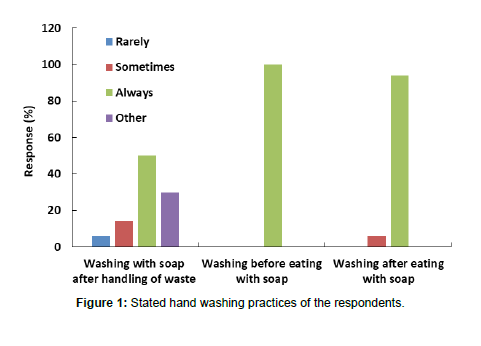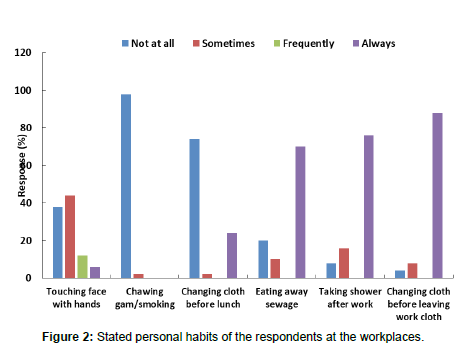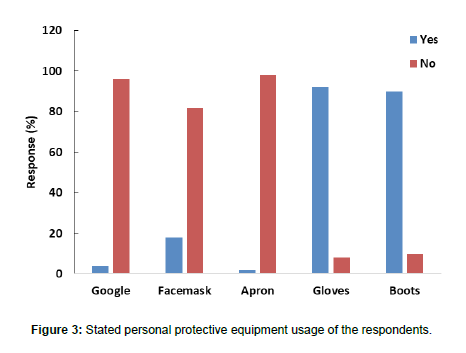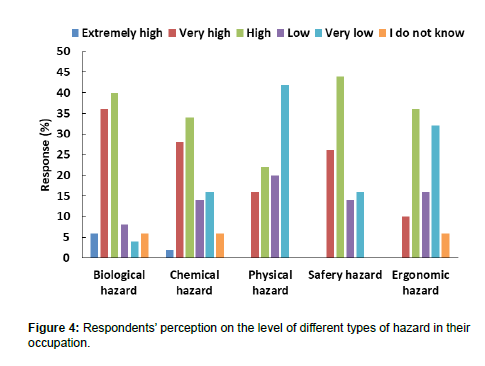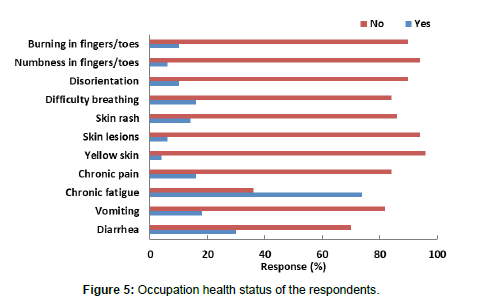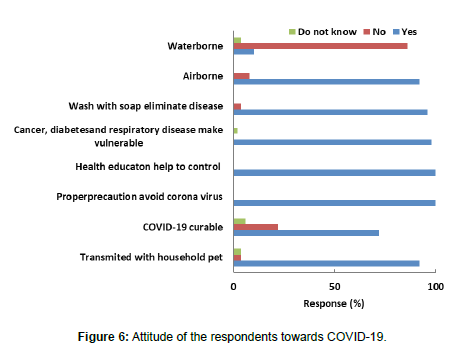Occupational Health and Safety Practices among Workers Involved Wastewater Collection and Treatment in Addis Ababa, Ethiopia
Received: 01-Nov-2022 / Manuscript No. omha-22-80081 / Editor assigned: 04-Nov-2022 / PreQC No. omha-22-80081 / Reviewed: 18-Nov-2022 / QC No. omha-22-80081 / Revised: 22-Nov-2022 / Manuscript No. omha-22-80081 / Published Date: 30-Nov-2022 DOI: 10.4172/2329-6879.1000437
Abstract
Workers involved in sewage collection, transport and treatment are exposed to different types of occupational health and safety hazards. The objective of this study was to assess the occupation health and safety awareness and practices of workers involved in wastewater management system in Addis Ababa, Ethiopia. A cross sectional design was used to assess the knowledge, attitude and practice of the workers. The survey was conducted using mobile phones and the mWater surveyor platform to maintain social distancing due to COVID-19 and a total of fifty respondents were involved in the study. All respondents stated that they frequently wash hands at the workplace. However, due to lack of adequate facilities, 12 % of workers do not change their work costumes before having lunch and neither washes their costume nor takes a shower before leaving the workplace. Only few workers (96 %) use a facemask, goggle and apron. The workers are directly exposed to different hazards due to lack of personal protective equipment (PPE) and/or reluctance to use PPE. The medical histories of the workers suggest that they have been exposed to various health problems due to exposure to hazards at the workplace. The findings of this study indicate that urgent action is needed to provide more PPE, showering facilities, and also to provide awareness and training on occupational health and safety to workers in order to prevent them from aforementioned hazards during wastewater collection, transport and treatment.
Keywords: Wastewater collection; Occupational Hazard; Knowledge and Practice; Personal Protective Equipment
Keywords
Wastewater collection; Occupational Hazard; Knowledge and Practice; Personal Protective Equipment
Introduction
Workers involved in sewage collection, transport and treatment practice face different types of occupational health and safety hazards. These workers are exposed to various chemical, biological, physical and occupational hazards [1,2]. Exposure risk to sewage involves potential intake of pathogens and toxins. Pathogens can be bacteria, fungi, parasites, protozoa, viruses and worms that can cause intestinal, lung and other infections [3-5]. Similarly, toxin can be gases like ammonia, carbon monoxide, hydrogen disulfide and methane. Exposures to such toxic gases can contribute towards oxidative stress and detrimental effects on various body functions including respiratory system problems (i.e., anoxia and asphyxia), altered pulmonary function parameters [6], gastrointestinal symptoms (jaundice and abdominal pain), airway symptoms (chronic bronchitis and toxic pneumonitis), eye irritation symptoms (conjunctivitis) and central nervous system symptoms (headaches and tiredness) [7].
The high pathogen loads in wastewater present potential risk to individuals who directly come in contact with wastewater during collection, transport (maintenance activities, combined sewer overflow) or the early stages of treatment. Similarly, wastewater treatment operators can have high exposure to pathogens during the operation of the wastewater treatment unless they are wearing appropriate PPE. In addition to pathogen exposure, workers are also exposed to different physical and safety hazards [2,8]. Many of the physical hazards are related to working outdoors (extremes in heat and cold), around wet surfaces and on uneven ground. Mechanical device such as mixing equipment, pumps and sludge rakes used for different type of operations in wastewater collection and treatment plants could injure and even sometimes results in fatalities if they are not safely operated. Wet surface in wastewater treatment plants can contribute to slipping and falling hazards. Noise from machinery can lead to sensor neural hearing loss slips. Heath problem resulted from ergonomic hazards are intervertebral disc herniation and musculoskeletal disorders like change of osteoarthritic and these are the most common spinal abnormalities reported [2].
Municipal wastewater collection and treatment operations must therefore ensure workers to follow practices to prevent intake of hazards from exposure to wastewater. The prevention includes using administrative and engineering controls and safe work practices [3]. Workers must get occupational health services that include preplacement and periodic health monitoring. There should be also regular awareness programs about safe working conditions and use of personal protective equipment [1,8]. In addition, wastewater collection and treatment workers must wear suitable protective equipment to prevent themselves from hazard exposures.
Companies involved in wastewater collection, transport and treatment have the responsibilities to protect their employees from occupational hazard. Baseline information regarding the knowledge, attitude and practice of wastewater management workers is critical to provide input for appropriate intervention to protect the workers from occupational hazards. Lack of awareness among site managers and workers and confidentially of accident reports hinder attempts to address concurrent hazards in wastewater treatment plants and solve those hazards using occupational health and safety management system [9]. Thus, the investigation of the origin and underlying causes of workrelated injuries, ill health, diseases and incidents should identify any failures in the occupational safety and health management system and should be documented [10]. Therefore, this study aims to assess and document occupational health and safety awareness and wastewater management in Addis Ababa. Ethiopia. Unlike Malakahmad et al. [9] who investigated hazards in wastewater treatment plants and Emmatty and Panicker [11] who addressed only wastewater collection workers, the occupational health and safety of workers involved in sewage collections, transport and treatment is addressed in this study. The findings of the study can be used to take corrective measures to reduce workers’ exposure to health hazard and assure their safety during wastewater collection, transport and treatment.
Material and Methods
Study population and participation
A cross-sectional survey was conducted by interviewing workers employed by the Addis Ababa Water and Sewerage Authority (AAWSA), who are involved in collection, transport, and treatment of sewage. The study was conducted in May, 2020 in two centralized sewage treatment sites (Kality and Kotebe) and seven decentralized sewage treatment sites. The decentralized treatment sites which are included in the survey were Tule Dimitu-01, 02 and 03; Bole Arabsa-01 and -02; Gelan pond treatment and Garment treatment sites. The survey respondents are 11 sewage collection and transporting drivers; 11 sewage collection workers; 10 sewage treatment operators from the Kality treatment site and 7 sewage treatment operators from the Kotebe treatment site. From the decentralized treatment sites, a total of 11 workers including treatment operators and sewage removing workers were interviewed in the study. A total numbers of the respondent were only fifty and this was mainly because of the lockdown due to COVID-19 pandemic. During the study period, the government put restriction in place to control the transmission of the disease. Thus, the interview was conducted using mobile phone and the mWater surveyor platform to maintain social distancing. Water is a tool that can be used to upload and visualize geospatial data describing water points, sanitation facilities, schools, health clinics, or communities and monitoring them over time with mobile surveys. The user can create space to store data from a particular site and to enter data drawn from a survey administered at that site.
The respondents were informed about the objective of the study and the confidentiality at the beginning of the survey, and informed consent was obtained from each respondent. It was stated to all the respondents that the results will be used for research purposes and their identity will be kept confidential.
Questionnaire and observation
A questionnaire was prepared with two main parts. The first part was designed to collect information regarding on the demographic details and the second part was designed to collect information on hygiene practice and occupation health. The questions were established based on some published literature and the researchers experience of knowledge, attitude and practice (KAP). The questions covered basic hygiene practices, personal habits, frequency of experiencing common hazards at the workplace and support received by workers as part of occupational safety and health management. Demographic variables included the age, educational background, gender, marital status and service years of the respondents. Most of the questions were responded on a yes/no (true/false) basis with an additional “I don’t know” option for some questions.
1. This cross-sectional survey was conducted among the medical 2. students from a government medical college, in Uttarakhand, from 3. 22th March to 25th March 2020, the week immediately before the 4. lockdown of India. 5. As we all know, social-distancing is the best way of prevention from 6. COVID-19, therefore, instead of conducting a communitybased 7. survey, this study collected the data using Google form platform as 8. an online survey. The link of Google form was posted and circulated 9. using various social media platforms like Whatsapp Group and 10. e-mail address of the students. The study participants were informed 11. about the details of the study objectives for filling the questionnaire 12. and confidentiality at the beginning of the survey, and informed 13. consent was obtained from each participant. It has been disclosed to 14. all the participants that their identity will keep confidential and the 15. results will be used only for research purposes. Among these 360 16. responses, 6 were incomplete, therefore, our final samples were 354 17. Questionnaire 18. A self-designed questionnaire was prepared, which comprised two 19. parts to collect demographic details of the participants along with 20. KAP towards COVID-19. The questions were established on the 21. basis of some published literature[12,13] and the authors’ experience 22. of KAP. After the preparation of the questionnaire, it was sent to 23. some experts to consult their opinions regarding the validity of the 24. questionnaire followed by a small pilot study to test its simplicity 25. and difficulty. However, the results of the pilot study were not
26. included in the actual samples used for the study. 27. The first part of the questionnaire covered demographic information 28. of the participants and the second part contained questions for 29. KAP assessment. Demographic variables included age, gender, and 30. religion. The self-designed questionnaire comprised 11 questions 31. regarding knowledge, 4 for attitude, and 8 for practice. Knowledge
The questionnaire was sent to experts to receive their feedback. Then the validity of the questionnaire was tested in a small pilot study to check clarity and simplicity of the questions. However, the data of the pilot study are not included for the study.
Results and Discussion
Demography Profile
The majority of the respondents (92%) were male while 8% were female which reflects that the workplace is male dominated. The respondents were in the age range from 26 to 59 years old. Most of the respondents were in the range of 30-49 years old. Nearly eight out of the ten respondents are married indicating that they are shouldering the responsibility of providing food for the family [Table 1]. Only one out of five respondents was living in their own house with most of them (54%) living in a rented or their parents’ house (26%). Two-third of the respondents was serving for less than 10 years in the waste management sector. The remaining of them have 10 to 30 years’ experience in the sector. All the study participants were literate having attended at least primary school. Around 40% of the participants attended education at college and above college levels. All the decentralized treatment operators had graduated at least with a college level education. Basic hygiene practices at workplace
| Variable | Category | Frequency (n) | Weighted percent (%) |
|---|---|---|---|
| Gender | Male | 46 | 92 |
| Female | 4 | 8 | |
| Age | 26∼29 | 9 | 18 |
| 30∼39 | 17 | 34 | |
| 40∼49 | 18 | 36 | |
| 50∼59 | 6 | 12 | |
| Experience | <5 | 13 | 26 |
| 5∼9 | 19 | 38 | |
| 10∼19 | 7 | 14 | |
| 20∼29 | 9 | 18 | |
| ≥30 | 2 | 4 | |
| Educational background | Primary | 9 | 18 |
| Secondary | 21 | 42 | |
| College and above | 20 | 40 | |
| House owner ship | Self-own | 10 | 20 |
| Rent | 27 | 54 | |
| Family | 13 | 26 |
Table 1: Demographic Characteristics of Respondents.
The hand washing practice of the respondents is shown in [Figure 1]. The majority of the respondents state that they always wash their hands with water and soap after handling of waste. However, 6 and 14% of the respondents state they wash hands rarely or sometimes, respectively. The majority of the wastewater collection truck drivers believe that they do not have direct contact with the waste and hence do not need to wash hands frequently. In addition, some waste collection assistants wash their hands only sometimes due to time constraints. AAWSA have assigned a daily quota (minimum amount of sewage to be collected in one day) for workers who are involved in sewage collection and transport. Some respondents said this created shortage of time to practice good hand hygiene and to have time for lunch. The remaining 30% of the respondents which are represented as ‘other’ in Figure 1 are workers involved on the sludge removal. These workers remove sludge and other floating materials from the waste throughout their working time. Due to the nature of their work, they wash their hands only during lunch time before eating their lunch and after work before leaving the work site.
All the respondents state they wash their hands with soap before eating meals. However, they miss washing hands when eating snacks at work site (for example, when they eat inside the truck). In addition, washing hands after eating are also common practices for majority of the respondents even if some of them wash their hands without soap. However, a few of the respondents state they are washing their hands only sometimes.
Non-availability of water in the customer house during waste collection was raised as a major challenge to practice hand washing after handling waste. Respondents stated two major reasons for this which are (i) due to interruption of water supply during the waste collection time and (ii) some customers do not have positive attitude towards waste collection workers. Similarity, there is also interruption of water supply in the centralized treatment sites. Among the decentralized treatment, water supply has been interrupted in one of the treatment sites for more than two months. We observed that all the decentralized treatment sites do not have a hand washing facility. In addition, soap is not made available to the workers on time because of the slow procurement process.
Work and Personal Habits of the Respondents
Figure 2 shows the respondents’ personal habits at the workplace.
Almost all the respondents (98%) state they do not chew gums and smoke tobacco at the workplace. More than half (56%) of the respondents said that they sometimes touch their faces while handling waste. On the other hand, 6% respondents said that they always touch their faces at the workplace mainly due to bad habits. This indicates that six out of ten respondents touch their face sometimes or always while handling waste. Operators in the decentralized treatment sites and some truck drivers believe that they do not have direct contact with the sewage (waste).
The work clothes might be contaminated by the waste which indicates the need to change clothes during lunch time. However, nearly three-fourth of the respondents stated that they do not change their work clothes at all during lunch times. Most of the workers involved in waste collection and driving the trucks do not change their clothes at lunch time. Some drivers and waste collection assistants do not eat lunch at all due to time constraints while the others stated that they are not interested to change their cloths without taking shower. However, those involved in sludge removal and operation of the treatment plant always change their clothes.
Taking a shower is considered as a common practice before leaving workplace to go home. About three-forth (76%) of the respondents state they always take a shower before leaving their work site to go home. The remaining respondents (treatment operators and workers at sludge removal in the decentralized treatments and two sludge collection truck drivers) take shower sometimes (16%) or do not take shower at all (8%). There is a critical shortage of showers at both Kality and Kotebe treatment sites. The number of the available showers in these treatment sites is not sufficient compared with the number of users/ for the workers involved in waste collection and treatments. All the decentralized treatment sites do not have showering facilities in their compounds. Thus, workers in the decentralized treatment sites either do not take showers before leaving their workplace or they shower in the open space.
In addition, 88% of the respondents always change into clean cloths before leaving the workplace. On the other hand, 8% of the respondents (one operator of decentralized treatment and all the others were drivers) sometimes change their clothes and 4% of the respondents (all were drivers) state they do not change their clothes. The results of the study showed that none of the respondents wash their work clothes with chlorine solution or bleaching agent. Rather they wash their clothes using liquid detergent which is known as “largo” locally.
Most of the respondents (70%) state they do not eat around sewage handling areas at all. On the other hand, 20% of the study participants said they eat around waste handling sites. For instance, drivers and assistants of waste collectors eat snacks inside the truck. Workers at the decentralized treatment sites also eat within the small compound of the treatment site.
Figure 3 shows that nearly all respondents (96%) do not wear eye goggles. This is mainly due to either lack of supply of the eye goggle or poor quality of the eye goggle which reduces visibility and creates discomfort. These types of working practice might increase exposure of the eyes of the workers to hydrogen sulfide and methane [8]. These chemical substances may initiate inflammatory reactions on the eyes mucous membranes [4, 8].
Similarly, none of the respondents always wear a waterproof apron before the COVID-19 outbreak. Respondents who are removing sludge in Kality and Kotebe treatment sites have aprons which they use whenever they think it is necessary to wear the apron. However, respondents involved in waste collection and sludge removal in the decentralized treatment sites do not have a waterproof apron. Similarly, 82% of the respondents do not use droplet resistant. Thus, most of the workers are potentially exposed to noxious substances like bacteria, fungi, hydrogen sulfide and methane via inhalation [1, 3]. These substances can lead to the development of respiratory problems and impairment of pulmonary function [12-14], producing chronic bronchitis, cough, throat irritation and wheezing [3].
There is a supply of gloves and plastic boots to the workers. Nearly nine out of ten respondents said they wear gloves and boots at their workplaces. The major concern raised in the study was the poor quality of the gloves. At the decentralized treatment sites, sharp materials are contained in the raw wastewater which can easily damage the gloves and cause injury and infection risks.
The results of the respondents’ perception on the level of hazard associated with waste collection and treatments are presented in [Figure 4]. They rated the biological hazard as extremely to very high (36%) or high (40%). Particularly, the workers involved in sludge removal and assistance of wastewater collection are very concerned about their exposure to biological hazard. The wastewater from domestic sources contains potential biohazards such as bacteria, endotoxins, viruses and protozoa [15-17]. Thus, workers in wastewater collection and treatment may be exposed to pathogens and endotoxins through the route of inhalation or hand-to-mouth. The result of this study showed that most of the workers have adequate knowledge regarding the biohazardous nature of domestic wastewater. However, one fourth of the respondents (mostly treatment plant operators followed by drivers of wastewater collection truck) stated that the level of biological hazard is low.
Similarly, 64% of the respondents rated the chemical hazard at the workplace as high, very high or extremely high. All assistants of wastewater collection, 64% of truck drivers and half of treatment operators and sludge removers rated the level of chemical hazard is at least high. All the remaining 36% of respondents (half of the respondents from treatment plant operator and sludge removal) rated the level of chemical hazards as low or very low.
In contrast to the above two hazards, the level of physical hazard was rated as low and very low by most of the respondents (62%). However, 38% of respondents (assistance of wastewater collection, drivers and sludge removal workers) rated the workplace physical hazard either high or very high level. The high level of noise emanating from the pump during waste collection and high ambient temperature for the Kality wastewater treatment site was also a concern for the workers. Seven out of ten respondents rated safety hazard as either very high (26%) or high (44%). In particular, 85% of sludge removal workers, 64% of the drivers and 55% wastewater collection assistants stated that the safety hazard at the workplace is high or very high. During wastewater collection from toilets, disposal in the treatment plant and operation of the treatment system workers might lose their life due to drowning, falls, collapse of pit latrine and trenches. For example, the respondents informed us that one sewage collection assistant died by drowning at the Kotebe treatment site just two weeks prior to our survey.
The respondents explained that the safety hazards at their workplaces include injury, fall, emission of noxious gas, spray of wastewater and cutting during wastewater collection and sludge removal. As it is observed during the assessment, the operators at the decentralized treatment plants do not use a safety belt when they open valves in the treatment system. They are thus highly vulnerable for falling and drowning into the wastewater treatment plant. The number of respondents rated ergonomic hazards as low and very low was equivalent to the number of respondents that rated it high and very high. Most (72%) of the wastewater collection assistants and 45% of sludge removal workers replied either high or very high level of ergonomic hazards. Friedrich [18] reported high prevalence of neck, upper back and lower back pain (LBP) at the sewage handling sites, where work disability due to LBP was significantly and positively associated with age, disability and higher abnormal illness behavior scores.
Figure 5 shows the responses regarding health history. As is shown in the Figure, three-fourth of the total respondents faced fatigue because of the nature of their work. This was stated by 81% of the wastewater collection assistants, 72 % of the drivers, and 55% of workers involved in sludge removal, whereas 50% of treatment operators are experiencing fatigue. Diarrhea is the second most common health problem that the respondents (30%) experienced. Most of them were from workers involved in treatment operators (50%) and assistance of wastewater collection (45%). All the treatment operators who had experienced diarrhea were from decentralized treatment sites. This could be due to the use of treated wastewater for washing of their hands. As it was observed during the site visit and interview of the workers, the treated wastewater appears very clean visually. However, there was not disinfection process in the treatment process to remove pathogenic microbes in the water. The workers are using the treated wastewater for washing their hands before drinking water tap supplied to them. Vomiting was also stated by 18% of the respondents while 16% of the respondents have also experienced skin rash and chronic pain. One long-serving wastewater collection assistant is experiencing chronic fatigue, diarrhea, disorientation, difficulty breathing, and skin rash and vomiting.
In comparisons with truck drivers and treatment operators, wastewater collection assistants and workers involved in sludge removal were disproportionally experiencing different types of health problems. This might be attributed to more direct exposure to biohazard and chemical hazards due to unsafe working conditions. This could be partly due ignorance with regards to usage of personal protective equipment and partly due lack of personal protective equipment. As it was also observed during the field visits, some workers did not use protective equipment including proper shoes.
Respondents’ Attitude about SARS-CoV-2
All the respondents agreed on the positive role of health education to control the corona virus and the need to implement proper preventive measures to avoid COVID-19 [Figure 6]. In addition, 98% of the respondents agreed that washing hands with soap and water eliminate the COVID-19 disease. What is striking is that nine in ten respondents consider the disease as airborne. This was very interesting information since this survey was conducted before the WHO classified COVID-19 as airborne disease.
Almost all the respondent agreed that people with cancer, diabetes and chronic respiratory disease are more vulnerable to the disease. Moreover, 92% of the respondents believe that household pets transmit COVID-19. Current research finding shows that infected human with COVID-19 can transmit to other animals including cats, dogs and farmed mink [19]. However, there is no clear evidence on the transmission of SARS-CoV-2 from pet animal to human [20-21].
Conclusion and Recommendation
Hazards mitigation is an essential process in waste collection, transport and sewage treatment plant towards promoting occupational health and safety. The use of personal protective equipment is found to be low, sanitary facilities are not adequate at the workplace and customers are not fully cooperative due to stigmatization of workers. These factors cause exposure risks to health hazards and safety problems at the workplace. As a result, the workers may be exposed to chemicals and reagents, have contact with infectious wastewater, and encounter unsafe physical working conditions. The type and level of health hazard and safety problems faced by the workers depend on their work type. Fatigue is the most common health problem for workers involved in wastewater collection and treatment. Diarrhea is a common health problem for the centralized treatment operators and wastewater collectors. A systematic approach using an occupational health and safety management system (OSHMS) is an appropriate solution to address and control the hazards.
Acknowledgement
This research work was supported by Water Security and Sustainable Development Hub funded by the UK Research and Innovation’s Global Challenges Research Fund (GCRF), grant number: ES/S008179/1, and the Royal Society, grants ICA\R1\191241. We thank the Addis Ababa Water and Sewerage Authority for providing the necessary support to conduct this research.
References
- Shafik SA, Abdelmegeed HA, Saad AM, Abo Elnour RA (2019) Occupational Health Hazards among Workers in Sewage Treatment Plants in Beni-Suef Governorate. J Nurs Health Sci 8: 204-218.
- Tiwari RR (2008) Occupational health hazards in sewage and sanitary workers. Indian J Occup Environ Med 12:112–115.
- Haleema M, Bhargava M, Nirgude AS (2019) An occupational health survey of sewage treatment plant workers of Dakshina Kannada, Karnataka. Int J Community Med Public Health 6:1467-1471.
- Jaremków A, Kawalec A, Pawlas K (2018) Harmful factors in wastewater treatment plant – knowledge and awareness of workers about hazards. Probl Hig Epidemiol 99(2): 189-195.
- Hansen ES, Hilden J, Klausen H, Rosdahl N (2003) Wastewater exposure and health— a comparative study of two occupational groups. Occup Environ Med 60: 595-598.
- Shadab M, Agrawal DK, Aslam M, Islam N, Ahmad Z (2014) Occupational health hazards among sewage workers: Oxidative stress and deranged lung functions. J Clin Diagn Res 8: 11-12.
- Albatanony MA, El-Shafie MK (2011) Work-related health effects among wastewater treatment plants workers. Int J Occup Environ Med 2: 237- 244.
- Thorn J, Beijer L, Rylander R (2002) Work related symptoms among sewage workers: a nationwide survey in Sweden. Occup Environ Med 59: 562- 566.
- Malakahmad A, Downe AG, Fadzil SD (2012) Application of occupational health and safety management system at sewage treatment plants. Eng Technol 347-350.
- Emmatty F, Panicker VV (2019) Ergonomic interventions among waste collection workers: A systematic review. Int J Ind Ergon 72:158-172.
- Jahangiri M, Neghab M, Nasiri G, Aghabeigi M, Khademain V, et al. (2015) Respiratory Disorders Associated with Occupational Inhalational Exposure to Bioaerosolsamong Wastewater Treatment Workers of Petrochemical Complexes. Int J Occup Environ. Medicine 6: 41-49.
- Lavoie J, Dunkerley CJ (2002) Assessing waste collectors' exposure to bioaerosols. Aerobiologia 18: 277-857.
- Nethercott JR, Holness DL (1988) Health Status of a Group of Sewage Treatment Workers in Toronto, Canada. Am Ind Hyg Assoc J 49: 346-50.
- Nega R (2018) Microbial Environmental Risks Associated Sewage Sludge Disposal. J Microbiol Biotechnol 3: 2.
- Chahal C, Akker B, Young F, Franco C, Blackbeard J (2016) Pathogen and Particle Associations in Wastewater: Significance and Implications for Treatment and Disinfection Processes. Adv Appl Microbiol 97:63-119
- Abdel-Raouf N, Al-Homaidan A, Ibraheem I (2012) Microalgae and wastewater treatment. Saudi J Biol Sci 19: 257-275.
- Friedrich M, Cermak T, Heiller I (2000) Spinal troubles in sewage workers: Epidemiological data and work disability due to low back pain. Int Arch Occup Environ Health 73:245–254.
- Sit TH, Brackman CJ, Tam KW, Law PY, Veronica YT, et al. (2020) Infection of dogs with SARS-CoV-2. Nature 586:776-778.
- Newman A, Smith D, Ghai RR, Wallace RM, Torchetti MK, et al. (2020) First reported cases of SARS-CoV-2 infection in companion animals—New York, March–April 2020. Morb Mortal Wkly Rep 12:69: 710.
- Oreshkova N, Molenaar RJ, Vreman S, Harders F, Munnink BB, et al. (2020) SARS-CoV2 infection in farmed mink, Netherlands, April 2020. Euro Surveill 25: 2001005
- World Health Organization. Transmission of SARS-CoV-2: implications for infection prevention precautions: scientific brief. World Health Organization (2020).
Indexed at, Google Scholar , Crossref
Indexed at, Google Scholar , Crossref
Indexed at, Google Scholar , Crossref
Indexed at, Google Scholar , Crossref
Indexed at, Google Scholar , Crossref
Indexed at, Google Scholar , Crossref
Indexed at, Google Scholar , Crossref
Indexed at, Google Scholar , Crossref
Indexed at, Google Scholar , Crossref
Indexed at, Google Scholar , Crossref
Indexed at, Google Scholar , Crossref
Indexed at, Google Scholar , Crossref
Indexed at, Google Scholar , Crossref
Indexed at, Google Scholar , Crossref
Indexed at, Google Scholar , Crossref
Indexed at, Google Scholar , Crossref
Citation: Hiruy AM, Haile AT, Acharya K, Werner D (2022) Occupational Health and Safety Practices among Workers Involved Wastewater Collection and Treatment in Addis Ababa, Ethiopia. Occup Med Health 10: 437. DOI: 10.4172/2329-6879.1000437
Copyright: © 2022 Hiruy AM, et al. This is an open-access article distributed under the terms of the Creative Commons Attribution License, which permits unrestricted use, distribution, and reproduction in any medium, provided the original author and source are credited.
Select your language of interest to view the total content in your interested language
Share This Article
Recommended Journals
Open Access Journals
Article Tools
Article Usage
- Total views: 3450
- [From(publication date): 0-2022 - Dec 09, 2025]
- Breakdown by view type
- HTML page views: 2992
- PDF downloads: 458

